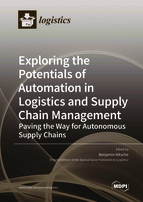Exploring the Potentials of Automation in Logistics and Supply Chain Management: Paving the Way for Autonomous Supply Chains
A special issue of Logistics (ISSN 2305-6290).
Deadline for manuscript submissions: closed (1 April 2021) | Viewed by 43686
Special Issue Editor
Interests: international logistics networks; supply chain volatility; automation in logistics and supply chain management; autonomous logistics networks; supply chain twins; agri-food supply chains; the role of Africa in international logistics networks
Special Issues, Collections and Topics in MDPI journals
Special Issue Information
Dear Colleagues,
The automation of physical and informational processes is one of the major trends in logistics and supply chain management (LSCM). Companies that master this trend can react more efficiently to rising cost pressure, increasing product and supply chain complexity, as well as rising customer demand for greater individualization. Possible application areas of automation in LSCM are diverse, ranging from informational process automation of planning processes (e.g., forecasting, purchasing, capacity allocation, event management) to automation of physical processes (e.g., in-house operations, last-mile distribution) and many others. Due to the constantly growing possibilities in the processing of large amounts of data and the further developments in the area of artificial intelligence and machine learning, it seems like the sky is the limit for automation in LSCM.
Although the potentials of automation in LSCM are diverse and acknowledged by the industry, the majority of companies face huge challenges when automating processes. Lack of data accuracy and quality, not standardized processes, system interface issues, lack of qualified human resources or missing commitment of either own management and staff or supply chain partners (suppliers, customers, logistics service providers) are just a few challenges that could lead to cost explosions for automation projects.
However, if those challenges can be mastered, even more advanced systems, such as autonomous logistics systems that exceed the automation of processes by autonomous decisions (e.g., by software agents), are conceivable and partly already in development. If not already with the automation of processes, at the latest with the development of autonomous logistic systems, the question arises of which role humans will play in these systems in the future. Companies must therefore find ways to increase the social acceptance of such systems and to define new requirements for their employees.
This Special Issue seeks to contribute to the discussion about the potentials of automation in LSCM to pave the way for automated, semi-autonomous, and possibly autonomous supply chains. Authors are cordially invited to submit original research papers, review articles, empirical studies, and case studies (for teaching and training) for the special issue to Logistics until 28 February 2020. Manuscripts or papers can be submitted on the following topics:
- Investigation of automation applications in supply chain planning and control, purchasing, forecasting, risk management, in-house transportation, distribution, capacity allocation, aftersales, and others;
- Estimation/quantification of potentials of automation in LSCM;
- Investigation of success factors of process automation in LSCM;
- Systematization of use cases of autonomous logistics systems;
- Autonomous agent-based approaches in LSCM;
- The role of humans in semi-autonomous and autonomous logistics systems;
- Investigation of new business models arising from process automation and autonomous logistics systems;
- Case studies in this field for teaching and training.
This list is not exhaustive. Other articles in the field of automation and autonomous systems in LSCM are highly welcome. I look forward to your submissions.
Dr. Benjamin Nitsche
Guest Editor
Manuscript Submission Information
Manuscripts should be submitted online at www.mdpi.com by registering and logging in to this website. Once you are registered, click here to go to the submission form. Manuscripts can be submitted until the deadline. All submissions that pass pre-check are peer-reviewed. Accepted papers will be published continuously in the journal (as soon as accepted) and will be listed together on the special issue website. Research articles, review articles as well as short communications are invited. For planned papers, a title and short abstract (about 100 words) can be sent to the Editorial Office for announcement on this website.
Submitted manuscripts should not have been published previously, nor be under consideration for publication elsewhere (except conference proceedings papers). All manuscripts are thoroughly refereed through a single-blind peer-review process. A guide for authors and other relevant information for submission of manuscripts is available on the Instructions for Authors page. Logistics is an international peer-reviewed open access quarterly journal published by MDPI.
Please visit the Instructions for Authors page before submitting a manuscript. The Article Processing Charge (APC) for publication in this open access journal is 1400 CHF (Swiss Francs). Submitted papers should be well formatted and use good English. Authors may use MDPI's English editing service prior to publication or during author revisions.
Keywords
- process automation
- autonomous systems
- agent-based
- Supply Chain 4.0
- robotic process automation
- artificial intelligence
- machine learning






